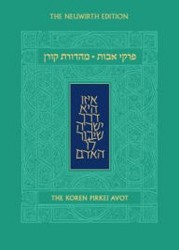Through its pithy apothegms and metaphysical wanderings, the compendium of sayings that constitute Pirkei Avot (“Ethics of the Fathers”) has challenged and enlightened readers for millennia. As a constituent piece of the Talmud, the chapter of Avot remains a go-to source for wisdom and pedagogic excellence, a staple for ethical discussion from living rooms to college lecture halls.The amount of commentary that has been expended on these sayings from the ancient Sages is considerable. Many of the brightest minds in Jewish history have disseminated the manifold meanings of the words of the sages, contextualizing these venerable precepts for contemporary audiences as well as for future generations.
While there are many commentaries to choose from, one of the most interesting and engaging is the recently released Illustrated Pirkei Avot by Jessica Tamar Deutsch. Navigating between the serious and whimsical with equal measure, Deutsch has transmuted every word of Pirkei Avot from the stuff of parchment and crinkled pages to a handsome, singular collection of sequential art and imagination. (For good measure, the entire tractate is reproduced at the back of the book, just in case readers want to refer to the original while reading.)
In this way, Deutsch’s work is a new paradigm. It would be too much to say that this work breaks all the rules of normative Talmudic commentary; that was probably never her intention. To the contrary, the accessibility stems from the book’s appeal to all ages in a welcoming way. One could be a scholar or a neophyte when it comes to learning Talmud and still learn something from this work. At times Deutsch inserts a thought that is separate from the art (i.e. the story of Hillel and the skull) that adds an element of reader/author interaction where it might not exist in other commentaries.
Does the entire enterprise of the Illustrated Pirkei Avot succeed to its fullest potential? It comes close for sure. Evaluating this book leads to bifurcated thoughts. On the one hand, is this a purely educational tool meant to elucidate and clarify classical rabbinic thought? Or, perhaps, is this comic a cosmic deconstruction of the countless other commentaries that have come before, being more accessible but less in-depth? The answer is probably somewhere in the middle. “My greatest hope,” Deutsch writes in her introduction “is that, in reading this, the teachings feel relevant to your life.” That’s a daunting task, but an intriguing one as well. Exploiting the nexus of comics and cartooning to delve into the timeless lessons of Pirkei Avot is this book’s strongest asset.
Overall, Deutsch’s contribution to the canon of commentary through her Illustrated Pirkei Avot is the first step on what should be a long career of combining the best of comix and Jewish thought. This is a worthy debut, perfect for readers young and old alike.




